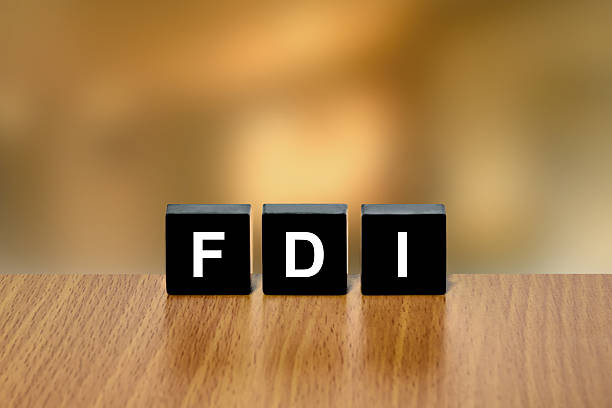
India has received $165 billion in foreign direct investment in India in the last two years. Even though the second wave decimated India, corporations from 101 countries invested in 57 sectors in 2021-22. The world was reeling from Covid-19 throughout these pandemic years. So the question is, when will India’s FDI reach the $100 billion mark a year?
They were willing to put their money on the India narrative over the Covid story. The total inflows to India during the epidemic years—$81.9 billion in 2020-21 and $83.5 billion in 2021-22—were higher than what the country received in the first six years of Manmohan Singh’s tenure (2004-05 to 2009-10) or the first three years of Narendra Modi’s rule (2014- 15 to 2016-17).
FDI inflows comprise stock investments, reinvestment earnings, and other capital. According to the Reserve Bank of India’s latest figures for 2021-22, Karnataka was the top recipient state, receiving 38 percent of FDI equity inflows, followed by Maharashtra (26%) and Delhi (2%). (14 percent). Karnataka mostly got a foreign investment in computer software and hardware, automobiles, and education.
Will India be able to keep this up as the global economic situation intensifies due to the Ukraine conflict? Will it be able to attract $100 billion in foreign direct investment in a year? If so, when do you believe it will occur? So far, no targets have been announced by the Indian government.
According to Deepak Bagla, MD and CEO of Invest India, foreign direct investment is about more than just money; global recognition and trust are also about. “If we have a supportive global environment,” he claims, “we can have $100 billion in FDI inflows annually in 24 to 36 months.”
Only once in the last decade have FDI inflows decreased: in 2012-13. Mauritius (27 percent of total FDI equity inflows), Singapore (22 percent), the United States (9 percent), the Netherlands (7 percent), and Japan (7 percent) are the top five contributors to India’s FDI equity inflows throughout the period 2000-22. (6 percent). Singapore was the most popular investment destination in 2021-22, followed by the United States and Mauritius. However, India’s net foreign investments, calculated by subtracting inflows (Indians buying assets abroad or foreigners selling assets in India) from inflows (Indians buying assets abroad or foreigners selling assets in India), have been weak, particularly in the second year of the pandemic.
ACCORDING TO A RECENT RBI BULLETIN, net FDI declined to $39.3 billion in 2021-22 from $44 billion the previous year, “primarily to higher outward FDI by India and repatriation by foreign investors.” Net FDI is projected to diminish in the coming years as more Indian firms buy assets in other nations. However, India has received more foreign money throughout the pandemic and is unaffected by the net figures. It’s partly because, under the automatic method, most sectors are accessible to 100 percent FDI.
The kitty has grown thanks to focusing on ease of doing business and recent FDI policy reforms in industries like insurance, defence, petroleum, and telecommunications. Former Union Industry Secretary Ajay Dua believes India should actively seek foreign investment in the manufacturing sector by promoting its production-linked incentive (PLI). “The majority of India’s FDI comes from mergers and acquisitions.”
More FDI inflows into greenfield manufacturing projects are required. He argues, “We must constantly improve the PLI plan and use it to attract FDI.” The PLI plan is the main driver for a 76 percent increase in FDI in manufacturing in 2021-22.
“It’s true that if a foreign firm wants to invest in India but finds a state with superior incentives, we deploy our’ meet and beat’ method,” Ranjan said. India will surpass the $100 billion threshold in FDI thanks to an intense rivalry among states to attract foreign money.
Foreign direct investment (FDI) is desirable because it delivers technology, efficiency, and better management techniques to India, allowing it to join the global supply chain. Because multiplier benefits occur in India and FDI aids exports, FDI is preferred over imports from other countries.
Depending on the product, there is a growing domestic consumer market and a less expensive manufacturing base for exporting, the latter of which is especially relevant as companies seek to diversify away from past host locations. In India’s opinion, funding current account deficits with non-debt-creating inflows such as FDI is preferable to debt-creating inflows.
As seen by global rankings, India continues to be a desirable investment destination, and this has been reinforced during the post-Covid recovery. Sectors show India’s comparative advantage (particularly in R&D) and the desired result of reduced import dependency. At this rate, more than $120 billion is possible yearly in three years.
Computer software, as well as computer hardware, medications, and pharmaceuticals, all spring to mind. Add to those autos, telecommunications, financial services, trading, and renewable energy, a sector that India emphasizes. India is also a source of FDI. Now that the WTO is in limbo, bilateral trade and investment accords help FDI inflows, and FDI doesn’t automatically mean inward FDI into India. That is why India has been examining its current portfolio of regional and bilateral agreements and is currently negotiating new ones.

Karnataka, Maharashtra, Delhi, Tamil Nadu, Gujarat, and Haryana have received the most FDI inflows. Of course, this has a methodological flaw in that domestic and foreign investments are measured against the location of company headquarters rather than the manufacturing location. Nonetheless, this supports the notion that some states are more appealing travel destinations than others.
While liberalization takes place at the federal level, numerous additional clearances (land, labour, water, energy, and the environment, to name a few) occur at the state level, not to mention transportation and legal infrastructure. The response of nations will determine whether yearly inflows reach $120 billion or significantly more outstanding in three years.
Stock investments, earnings reinvested, and other capitals constitute FDI inflows. According to the PHDCCI analysis titled “Economy to Resume Normal Growth Curve in 2022-23,” India’s economic growth will be the highest among the world’s top economies in the current fiscal year.
According to the PHDCCI, India will likely receive $100 billion in foreign direct investment (FDI) in 2022-23 due to recent economic reforms and ease of business.
It has proposed a ten-point strategy to boost economic growth and help the country reach its goal of being a USD 5 trillion economy in the next five years.
Infrastructure investments should be made quickly, more industries should be included in the PLI plan, public investments in agriculture should be increased, and high commodity prices and raw material shortages should be addressed.
“An investment in knowledge yields the highest return.” Franklin, Benjamin
With the Industrial Policy Statements in 1980 and 1982, followed by the Technology Policy Statement in 1983, the government began liberalizing FDI from 1980 to 1991. Economists said India is being viewed as a safe and dynamic location for foreign investors due to the $100 billion milestones.
“The fact that India’s economy is developing at a rate of 6% per year adds to the country’s reputation as a safe and dynamic investment destination. If the economy continues to grow, FDI will increase dramatically. Investing here allows investors to diversify their portfolio away from China.” The CEO and Director of the ICRIER economic research institute, Rajiv Kumar, agrees.
In 2021-22, India’s FDI will reach an all-time high.
According to Narendra Modi, “FDI is both a responsibility for Indians and an opportunity for the rest of the world.” For the people of India, my definition of FDI is “First Develop India.”
In 2021-22, India received $83.57 billion in the “highest ever” annual FDI. The inflow was $81.97 billion in 2020-21.
“India is quickly becoming a preferred location for international investments in the industrial sector,” the government says.
“In the Financial Year 2021-22, India received the biggest ever yearly FDI inflow of Y83.57 billion,” it stated.
Compared to 2020-21 ($12.09 billion), FDI equity inflow into manufacturing sectors surged by 76% in 2021-22 ($21.34 billion).
Singapore topped the list of top investor countries with 27%, followed by the United States (18%) and Mauritius (16%) in the previous fiscal year.
Computer software and hardware drew the most inflows of all the sectors. According to the ministry, it was followed by the services sector and the motor industry.
To further liberalize and simplify FDI policy and attract investments, reforms have recently been implemented in coal mining, contract manufacturing, digital media, single-brand retail trading, civil aviation, defence, insurance, and telecommunications.
Which sector attracts the highest FDI in India?
During FY 2021-22, the largest recipient states of FDI equity inflow in the industry ‘Computer Software & Hardware’ are Karnataka (53 percent), Delhi (17 percent), and Maharashtra (17 percent). Karnataka is the largest receiving state, accounting for 38% of total FDI equity inflows in FY 2021-22, followed by Maharashtra (26%) and Delhi (2%). (14 percent).
The majority of Karnataka’s equity inflows in FY 2021-22 came from ‘Computer Software & Hardware (35 percent), ‘Automotive Industry’ (20 percent), and ‘Education’ (12 percent).
Over the last eight years, the government’s actions have paid off, as seen by the ever-increasing volumes of FDI influx into the country, which has established new records. To ensure that India remains an attractive and investor-friendly location, the government analyses the FDI policy regularly and makes necessary modifications from time to time. The government has undertaken a liberal and transparent FDI policy, with most sectors open to FDI through the automatic route.
Who introduced FDI in India? – Let’s take a Deep Dive
Foreign direct investment (FDI) is an investment made by an entity based outside the country where the investment is being made, either by purchasing a firm there or growing its business there.
Foreign direct equity inflows are major economic growth drivers. They are typically chosen over other types of external finance since they do not create debt, are non-volatile, and their returns are based on the performance of projects supported by foreign investors.
To gain a controlling interest in a business in a foreign country, the investor will purchase assets or develop corporate operations. This is distinct from buying foreign company stock, referred to as a portfolio investment.
FDI promotes the infusion of new technology, managerial expertise, fresh ideas, skills, knowledge, more significant employment, and enhanced infrastructure, in addition to helping a country’s economic progress.
According to the Foreign Exchange Management Act (FEMA), foreign direct investment (FDI) was first allowed in India in 1991, according to the Foreign Exchange Management Act (FEMA), which was signed into law by then-finance minister Dr Manmohan Singh. It began in 1990 with a one-billion-dollar starting point.
India is now regarded as a significant foreign direct investment destination. Telecommunications, construction, and computer software and hardware are the three key areas that draw foreign investment.
https://en.wikipedia.org/wiki/Foreign_direct_investment_in_India
Foreign direct investment is classified into three types.

Horizontal FDI occurs when a company replicates its home nation’s commercial activities in the same value chain in the country where the investment is made.
Vertical FDI occurs when a company climbs upstream or downstream in various value chains through foreign direct investment.
Platform FDI This sort of FDI occurs when a source country invests in a destination country to export to a third country.
Methods of foreign direct investment
Any of the following approaches can be used by foreign direct investment to achieve voting power in an economy:
-By incorporating a wholly-owned subsidiary or corporation in any location
-By acquiring stock in a related company
-Through the acquisition or merger of a non-related company
-By partnering with another investor or company in an equity joint venture.
India allowed foreign direct investment in cash and carried wholesale in 1997. This meant that any foreign investment into the country had to be approved by the government. However, in 2006, the necessity for prior clearance was relaxed, and automatic permission was implemented.
Foreign investment in an Indian company is permissible under the Foreign Exchange Management Regulations in the following ways:
-As a fully integrated entity by forming a business under the Companies Act of 1956 through joint ventures; or -As wholly-owned subsidiaries by creating a company under the Companies Act of 1956.
-As a foreign entity’s office through
-Representative Office/Liaison Office
-Project Management Office
-Office of a branch
The Economic Impact of Foreign Direct Investment in India
Foreign Direct Investment (FDI) promotes long-term economic growth. MNCs make technology transfer to indigenous enterprises easier. In enterprises, organic development or expansion occurs. The number of people employed is likewise rising.
Foreign direct investment strengthens a company’s balance sheet by expanding its assets. Profits for businesses rise, as does labour productivity. Consumption increases as per capita income rises. Government spending rises as tax revenues rise.
GDP rises, and there is a lag effect in which GDP increases in subsequent years. In addition, investments have a gestation time, and after a few years, returns increase.
Companies and, as a result, the economic benefit from FDI and the correct FDI process is the identification of critical sectors in the economy that yield the highest return on investment.
The balanced and unbalanced growth theories of development economics are concerned with this. Leibenstein’s idea of the least amount of effort is also flawed.
FDI also contributes significantly to India’s domestic stock of investment, which is low (around 32 percent) due to poor savings. This investment boosts company competitiveness, encourages innovation and efficiency and raises living standards by bringing better products and services to market.
Exports are boosted, and the balance of payments shows a surplus, causing the rupee to rise against the dollar. According to the Quantity Theory of Money, as forex reserves rise, RBI’s assets rise, causing the money supply to grow and inflation to rise.
So, in the open economy, bond prices rise, interest rates fall, the investment grows, and growth increases, according to the Mundell Fleming model.

Foreign Direct Investment (FDI) is preferable to Foreign Institutional Investment (FII), also known as “hot money,” which is highly volatile and flows between the stock and bond markets. Companies grow steadily due to FDI, and the stock market rises, attracting more money and raising more funds for firms.
Technology transfer, or the migration of technical know-how, occurs due to FDI, resulting in skill development, which, when combined with increased capital, increases productivity and profitability.
Total FDI inflows into the country in the last 20 years (April 2000 – September 2020) totalled 729.8 billion dollars, while total FDI inflows into the country in the previous five years (April 2014 – September 2019) totalled 319 billion dollars, accounting for nearly half of total FDI inflows in the last 20 years.
As a result of FDI, there is an improvement in technical know-how and the development of essential skills, lowering costs and increasing productivity.
FDI expands job opportunities in various industries, improves people’s lifestyles, and encourages investment in critical areas such as infrastructure development, resulting in increased capital goods output.
Many developing countries’ exports have increased as a result of FDI. The establishment of special economic zones and promotion of 100 percent export-oriented enterprises have aided foreign direct investment in growing exports from other countries.
FDI boosts a country’s financial services by expanding its banking business and other operations such as merchant banking, portfolio investment, and so forth. Because of the continual and ongoing supply of foreign exchange, the exchange rate is stable.
FDI is responsible for developing underdeveloped areas. Customers benefit from healthy competition because it enhances the number of options.
Initiatives of the Government to encourage foreign direct investment (FDI)
The government has changed the Foreign Exchange Management Act (FEMA) provisions, enabling up to 20% FDI through the automatic route in the insurance business LIC. The Indian government is considering loosening the rules on foreign direct investments from nations with which it shares a border.
-In 2022, measures such as PM Gati Shakti, single-window clearance, and a GIS-mapped land bank are projected to increase FDI inflows.
-As part of the Space Activity Bill in 2022, the government is expected to implement at least three policies. The scope of foreign FDI in the Indian space sector is expected to be explicitly defined by this bill.
-India and the United Kingdom agreed in September 2021 to increase investment to deepen bilateral connections as part of an ‘Enhanced Trade Partnership.’
-The Union Cabinet declared in September 2021 that, to promote the telecom sector, they will authorize 100% FDI via the automated method, up from the existing 49 percent.
-The government changed the Foreign Exchange Management (non-debt instruments) Rules 2019 in August 2021 to allow for a 74 percent increase in the FDI quota in the insurance sector.
ROAD AHEAD
According to a CII and EY estimate, India is anticipated to receive FDI worth US$ 120-160 billion per year by 2025. According to the Economic Times, investors placed India third in terms of attractiveness; 80% of investors want to invest in India in the next 2-3 years, with 25% reporting investments worth more than US$ 500 million.
India is ranked 43rd in the annual World Competitiveness Index 2021 published by the Institute for Management Development (IMD). According to the IMD, India’s improved government efficiency is primarily attributable to relatively stable public finances (despite COVID-19-related concerns) and optimistic feelings among Indian business players about government funding and subsidies. In addition, according to a Deloitte report released in September 2021, India remains an attractive market for foreign investments in the medium and long term.
Read more details on Inventiva – https://www.inventiva.co.in/
Edited by Prakriti Arora




